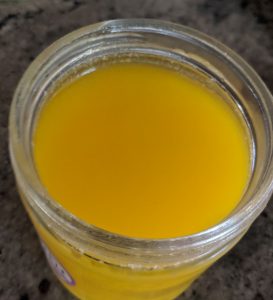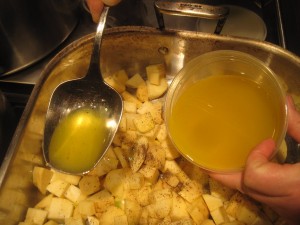We have now have a variety of chicken in the farmstand so here is a quick cheat sheet. What is the difference between fryers, broilers, roasters and stew birds?
Stewing Chickens—the easy one.
Stew birds are usually laying hens that have passed their prime. They are older and their meat can be tougher, but more flavorful. This type of chicken is best used in stews and soups where the meat has time to break down during the long, moist cooking. Many love them for chicken and dumplings and wonderfully flavored soups.
And our stewing hens also offer the most delectable schmaltz.

Regardless of how you cook the stewing hens, the most amazing golden yellow fat rises to the surface. So clear, radiant and beautiful. It reminds us of the color of our egg yolks.
Clearly, these hens are concentrating some delicious nutrition, including omega-3s, from the pasture, hay and organic grain and offering it back to us.
From our processing this week, we saw the thick layer of bright yellow fat in these hens. On some of them you have the option to just remove a big chunk of bright yellow fat and render it directly.
More thoughts: How to Cook a Stewing Hen (and why you should!) and our missive on Stewing hens and their schmaltz from when we fell in love with stewing hens.

Schmaltz from our stew hens as a great cooking oil
Fryers, Broilers and Roasters

The terms for these different kinds of chickens tend to get tossed about and used interchangeably in recipes and articles.
- Broilers: Chickens 6-8 weeks old and weighing about 2 1/2 pounds
- Fryers: Chickens 6-8 weeks old and weighing 2 1/2 – 3 1/2 pounds
- Roasters: Chickens 3-4 months old weighing over 4 lb.
Broilers, fryers, and roasters can be used interchangeably based on how much meat you think you’ll need. They are young chickens raised for their meat, so they are fine to use for anything from poaching to roasting. You may need to adjust cooking times based on what the recipe called for and the size of your chicken. Our chickens, raised on pasture, tend to cook more quickly than conventional chickens, we recommend using a meat thermometer to ensure you don’t overcook them if you are roasting them. We aim for 160-165 F and use a meat thermometer as our pasture-raised birds (and meat in general) cook MUCH FASTER than industrial meat and thus generally quicker than most recipes suggest.
Our favorite, really the only way we roast chickens as it is SO reliable, is Mark Bittman’s Simple Roast Chicken.
You can find more great recipes for using stewing hens and roasting chickens on our website, by searching chicken!
